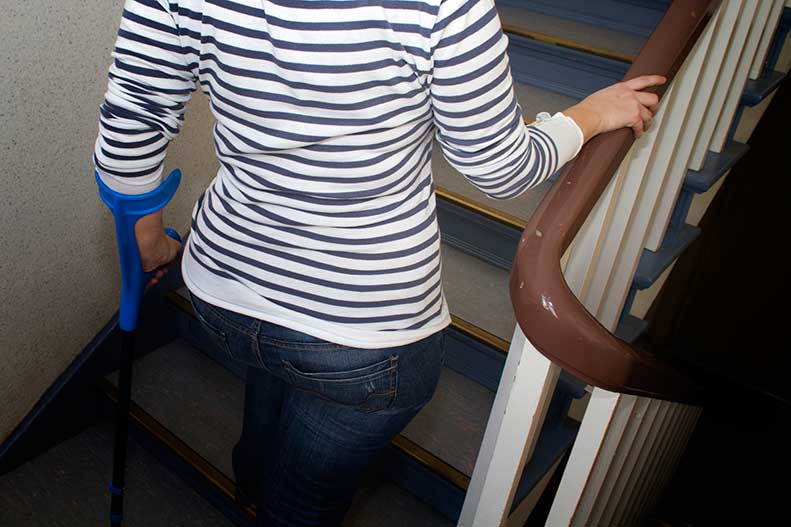When you break your leg or injure your foot and ankle, your mobility will be significantly limited. You may end up coming home with a pair of crutches to walk or climb stairs on your own. However, using crutches is not as easy as it may look. You may feel awkward to use crutches for the first time. It requires upper body flexibility and strength. Therefore, the right instruction before using them is really important. Here are some tips to help you use your crutches properly and safely.
Best fit crutches
Your crutches should be accurately sized. Even when you already have crutches at home, they might not be the right for you, meaning you need to adjust them or get new ones of the right size. Here are some few points you need to check to ensure your crutches is the best fit for you:
- The handles of the crutches are in line with the height of your hips, so your elbows are slightly bent when you use the handgrips.
- The crutch should be around one to two inches underneath your armpit while you are standing.
- Your shoulders should slightly lean forward when you use the crutches.

Check the grips and padding
Crutches that doesn’t have sufficient cushion on the grips, armpit, and the base that touches the floor are the reasons why you feel uncomfortable. Make sure your crutches have those because crutches without enough padding will result in pain. If the padding becomes worn, you can replace them in a medical supply store.
Crutch proof you’re home
Crutches can make your life more difficult. Some things can be hazards for you now, especially loose items on the floor. Ask a family member or a friend to remove electrical cords, rugs, toys, or anything else that could possibly trip you. Keep the items you need within reach and put everything else out of your way. Avoid using purses that you have to hold in your hand. The best bag, while you’re using crutches, is sling bags.
Standing up from a sitting position
Position both of your crutches in the hand of the affected side. For instance, if you injured your left leg, place both crutches by the handle with your left hand. Then, grasp the armrest of your chair with the other hand. Place your weight on your uninjured leg then push up with your arms.
Walking with crutches
Your ability to put weight on your injured leg determines the basic mechanics of walking with crutches on flat ground. If you’re unable to put weight on your injured leg, it is called non-weight bearing. Here’s how to walk with crutches when you can’t put weight on your injured leg:
- Position one crutch under each arm and grip the handles.
- Stand on your uninjured leg. Slightly bend and raise your injured leg off the floor.
- Spread the crutches about one foot in front of you.
- Move your injured leg forward.
- Use your hands to support your weight then step forward with your uninjured leg. When your uninjured leg on the floor, take the next step by advancing your crutch forward.
Some injuries or surgery allows you to put some weight on your injured leg. This is called weight-bearing and you can walk using the steps below:
- Put one crutch under each arm and grip the handles.
- Stand in between your crutches with both of your feet on the floor.
- Spread both crutches around a foot in front of you.
- Step forward with your injured leg, then place it lightly on the floor.
- Step with the uninjured leg and spread the crutches forward to take the next step.
Bear in mind that your crutches can easily get caught on things. Make sure you keep a wide area around you. To prevent injuries, try to practice the following things:
- Don’t look at your feet, instead look ahead to where you’re walking.
- Keep most of your weight on your hands, not your armpits.
- Take short steps.
- Rest often.
- Don’t rest your armpits on the top of the crutches as you can irritate the skin of your armpit.
Walking upstairs
It can be tricky to walk upstairs when using crutches since it requires a lot of upper body strength. If there’s a handrail, you should use it. Hold both crutches in one hand and the handrail with the other. Make sure all your weight is on your arms and bring the uninjured leg up one step. Then, bring the crutches up to that step. Repeat for each step.
If there is no handrail, use both of your crutches and lead with the uninjured leg. Stand very close to the step, put your weight on the crutches, and lift the uninjured foot up to the first step. Then, put your weight on the uninjured leg and bring the crutches up to the same step.

Walking downstairs
Walking downstairs is very challenging and dangerous. Take one step at a time and hold your injured foot in front of you. Hop down each step on your uninjured food using the crutches or handrails. The first few times you walk downstairs with crutches, make sure you have someone to keep an eye on you.
If both of your legs are injured
Crutches are usually not recommended when both of your legs are injured. This is because you need to be able to put weight on one of your legs in order to use crutches safely. If both of your legs are injured, your doctor will offer a different mobility aid, such as a wheelchair.
If all of the steps above are still too hard for you to follow, then watch this video below.